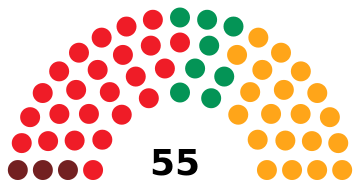Madrid City Council election, 1987
| | |||||||||||||||||||||||||||||||||||||||||||||||||||||||||||||||||||||||||||||||||||||||||
| |||||||||||||||||||||||||||||||||||||||||||||||||||||||||||||||||||||||||||||||||||||||||
| |||||||||||||||||||||||||||||||||||||||||||||||||||||||||||||||||||||||||||||||||||||||||
| |||||||||||||||||||||||||||||||||||||||||||||||||||||||||||||||||||||||||||||||||||||||||
The 1987 Madrid City Council election was held on Wednesday, 10 June 1987, to elect the 3rd Madrid City Council, the unicameral local legislature of the municipality of Madrid. At stake were all seats in the City Council, determining the Mayor of Madrid. The number of members decreased from 57 to 55 compared to the previous election.
The Spanish Socialist Workers' Party (PSOE) won the election, but lost its absolute majority and lost 137,000 votes compared to 1983. The People's Alliance (AP), which stood separately after the breakup of the People's Coalition in 1986, failed to meet the level of support reached by the coalition in 1983 and also lost votes and seats. Benefitting from both parties' losses was the Democratic and Social Centre (CDS), which, with its 8 seats and 15% of the votes, entered the City Council for its first and only time and went on to hold the balance of power. United Left (IU), an electoral coalition comprising the Communist Party of Spain and other left-wing parties, continued on its long-term decline and lost 1 more seat, barely obtaining 100,000 votes and 6% of the share.
AP and CDS together reached an absolute majority, but failure on reaching an agreement resulted in Socialist Juan Barranco being re-elected as mayor. However, on June 1989, both parties agreed to present a motion of censure on Barranco and elect Agustín Rodríguez Sahagún from the CDS as new mayor, ousting the PSOE from power in the city after a 10-year rule.
Electoral system
The number of seats in the Madrid City Council was determined by the population count. According to the municipal electoral law, the population-seat relationship on each municipality was to be established on the following scale:
| Inhabitants | Seats |
|---|---|
| <250 | 5 |
| 251–1,000 | 7 |
| 1,001–2,000 | 9 |
| 2,001–5,000 | 11 |
| 5,001–10,000 | 13 |
| 10,001–20,000 | 17 |
| 20,001–50,000 | 21 |
| 50,001–100,000 | 25 |
Additionally, for populations greater than 100,000, 1 seat was to be added per each 100,000 inhabitants or fraction, according to the most updated census data, and adding 1 more seat if the resulting seat count gives an even number. As the updated population census for the 1987 election was 3,058,182, the Madrid City Council size was set to 55 seats.
All City Council members were elected in a single multi-member district, consisting of the Madrid municipality, using the D'Hondt method and a closed-list proportional representation system. Voting was on the basis of universal suffrage in a secret ballot. Only lists polling above 5% of valid votes in all of the municipality (which include blank ballots—for none of the above) were entitled to enter the seat distribution.
The Spanish municipal electoral law established a clause stating that, if no candidate was to gather an absolute majority of votes to be elected as mayor of a municipality, the candidate of the most-voted party would be automatically elected to the post.[1]
Results
 | ||||||
| Party | Vote | Seats | ||||
|---|---|---|---|---|---|---|
| Votes | % | ±pp | Won | +/− | ||
| Spanish Socialist Workers' Party (PSOE) | 666,199 | 40.47 | |
24 | | |
| People's Alliance (AP)[lower-alpha 1] | 555,599 | 33.76 | |
20 | | |
| Democratic and Social Centre (CDS) | 247,773 | 15.05 | |
8 | | |
| United Left (IU)[lower-alpha 2] | 100,514 | 6.11 | |
3 | | |
| Workers' Party of Spain–Communist Unity (PTE-UC) | 25,059 | 1.52 | New | 0 | ±0 | |
| The Greens (LV) | 11,129 | 0.68 | New | 0 | ±0 | |
| Confederation of the Greens (CV) | 4,858 | 0.30 | New | 0 | ±0 | |
| Spanish Falange of the JONS (FE-JONS) | 4,592 | 0.28 | New | 0 | ±0 | |
| People's Democratic Party (PDP) | 3,727 | 0.23 | New | 0 | ±0 | |
| Humanist Platform (PH) | 2,475 | 0.15 | New | 0 | ±0 | |
| Spanish Juntas (JJEE) | 2,362 | 0.14 | New | 0 | ±0 | |
| Republican People's Unity (UPR) | 1,248 | 0.08 | New | 0 | ±0 | |
| Revolutionary Workers' Party of Spain (PORE) | 1,219 | 0.07 | New | 0 | ±0 | |
| Communist Workers' League (LOC) | 1,164 | 0.07 | New | 0 | ±0 | |
| Internationalist Socialist Workers' Party (POSI) | 1,083 | 0.07 | New | 0 | ±0 | |
| Blank ballots | 16,972 | 1.03 | |
|||
| Total | 1,645,973 | 100.00 | 55 | | ||
| Valid votes | 1,645,973 | 98.88 | |
|||
| Invalid votes | 18,607 | 1.12 | | |||
| Votes cast / turnout | 1,664,580 | 70.06 | | |||
| Abstentions | 711,430 | 29.94 | | |||
| Registered voters | 2,376,010 | |||||
| Source: Ministry of the Interior | ||||||
Notes
- 1 2 People's Alliance results are compared to the People's Coalition totals in the 1983 election.
- 1 2 United Left results are compared to the Communist Party of Spain totals in the 1983 election.
.jpg)
.jpg)

.jpg)